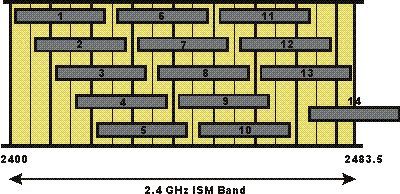Band/Bandwidth
频带(Band)
所谓的频带就是指分配给特定应用的频率范围.
无线设备被限定在某个特定的频带(Frequency Band) 上操作.
每个频带都有相应的带宽(Bandwidth),即该频带可供使用的频率总和.
带宽是评断链路(Link)数据传输能力的基准.种种理论证明较高的带宽可以传输更多的信息.
ISM 频带(2.4GHZ)即工业(Industrial),科学(Scientific),医疗(Medical):不需要申请许可证(License Free)即可使用.
IEE802.11a 设置使用5GHZ频带,IEE802.11b/g 设备使用ISM 2.4GHZ 频带,IEE802.11n使用 ISM 2.4GHZ 频带 及5GHZ频带
Channel
l 2.4 GHz (802.11b/g/n)
802.11 divides each of the above-described bands into channels, analogously to how radio and TV
broadcast bands are sub-divided but with greater channel width and overlap.
For example the 2.4000–2.4835 GHz band is divided into 13 channels each of width 22 MHz
but spaced only 5 MHz apart, with channel 1 centered on 2.412 GHz and 13 on 2.472 GHz to
which Japan adds a 14th channel 12 MHz above channel 13.
This chart is only provides a general view, and there may be variations between different countries.
For example some countries within the European zone Spain have restrictions on the channels that may be used
(France: channels 10 - 13 and Spain channels 10 and 11)
use of Wi-Fi and do not allow many of the channels that might be thought to be available,
although the position is likely to change.The channels used for WiFI are separated
by 5 MHz in most cases but have a bandwidth of 22 MHz.
As a result channels overlap and it can be seen that it is possible to find a maximum of three non-overlapping channels.
Therefore if there are adjacent pieces of WLAN equipment that need to work on non-interfering channels,
there is only a possibility of three.
There are five combinations of available non overlapping channels are given below:
From the diagram above, it can be seen that Wi-Fi channels 1, 6, 11, or 2, 7, 12, or 3, 8, 13 or 4, 9, 14 (if allowed)
or 5, 10 (and possibly 14 if allowed) can be used together as sets. Often WiFi routers are set to channel 6 as the default,
and therefore the set of channels 1, 6 and 11 is possibly the most widely used.
The 802.11 WLAN standards specify a bandwidth of 22 MHz and a 25 MHz channel separation,
although nominal figures for the bandwidth of 20 MHz are often given.
The 20 / 22 MHz bandwidth and channel separation of 5 MHz means that adjacent channels
overlap and signals on adjacent channels will interfere with each other.
Trout Channel bandwidth:
WIFI 20Mhz
BT 1Mhz
FM 200Khz

